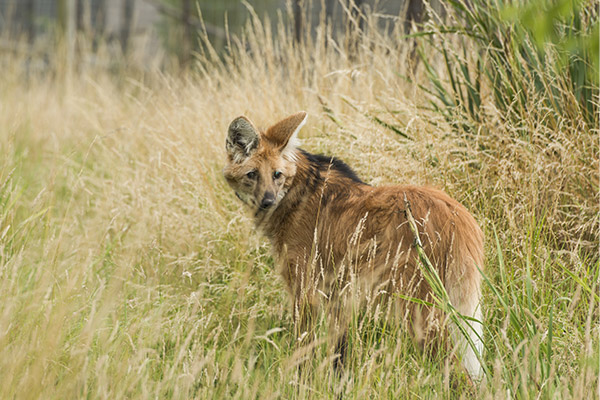What looks like a fox on stilts, has the word ‘wolf’ in its name but is neither fox nor wolf?
If you answered Maned Wolf, you know your canids well! If you have never heard of this beast, however, we are here to tell you about this remarkable creature.
The Maned Wolf (scientific name Chrysocyon brachyurus) is a bit of an anomaly in the vast Canidae family. It is not closely related to ‘conventional’ wolves and is the only species in the genus Chrysocyon – which, to make matters more intricate, means ‘golden dog’ – and the largest and most distinctive canine in South America. Its closest relative is the Falkland Islands Wolf, which became extinct in 1876. Unsurprisingly, its closest living relative is neither a fox nor a wolf – it is the Bush Dog, which, with its short legs and snout, looks very little like the Maned Wolf!

The Maned Wolf also has the unique distinction of being the world’s tallest wild canid, and for good reason! Maned wolves exclusively inhabit the Cerrado, one of the largest biomes of South America that consists largely of savanna, intermixed with patches of forest, grassland and wetland. The extra-long legs they have evolved allow them to see over the long grass in their habitat. Apart from its extra-long legs, the Maned Wolf has a distinct black mane and reddish-brown that makes it instantly recognizable.

The Maned Wolf’s diet separates it further from most extant canids. Over 50 percent of its diet comprises vegetation, of which the ‘wolf apple’ (Solanum lycocarpum, or lobeira in Portuguese) is a vital component, so named because of the Maned Wolf’s affinity for it.

Unfortunately, drastic reduction of habitat has reduced the numbers of the Maned Wolf, and many also end up as roadkill. We will be looking out for this magnificent canid species on our upcoming tour to Brazil as we visit the Cerrado habitat, and hope to have some wonderful viewings – on our previous trip, travellers saw Maned Wolves two nights in a row!


